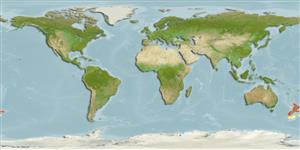Common names from other countries
Teleostei (teleosts) >
Zeiformes (Dories) >
Zeniontidae (Armoreye dories)
Etymology: Capromimus: Latin, capra = goat + Latin, mimus = imitator.
Environment: milieu / climate zone / depth range / distribution range
Ecology
Marine; bathydemersal; depth range 87 - 500 m (Ref. 27073). Deep-water; 33°S - 53°S, 165°E - 173°W
Southwest Pacific: New Zealand only.
Size / Weight / Age
Maturity: Lm ? range ? - ? cm
Max length : 10.0 cm TL male/unsexed; (Ref. 27073)
Minimum depth reported at 87 m (Ref. 58489)
Life cycle and mating behavior
Maturities | Reproduction | Spawnings | Egg(s) | Fecundities | Larvae
Amaoka, K., K. Matsuura T. Inada, M. Takeda, H. Hatanaka and K. Okada (eds.), 1990. Fishes collected by the R/V Shinkai Maru around New Zealand. Japan Marine Fishery Resource Research Center, Tokyo, Japan. 410 p. (Ref. 27073)
IUCN Red List Status (Ref. 130435)
CITES (Ref. 128078)
Not Evaluated
Threat to humans
Harmless
Human uses
Fisheries: commercial
Tools
Special reports
Download XML
Internet sources
Estimates based on models
Preferred temperature (Ref.
115969): 9.2 - 14.6, mean 13 (based on 41 cells).
Phylogenetic diversity index (Ref.
82804): PD
50 = 1.0078 [Uniqueness, from 0.5 = low to 2.0 = high].
Bayesian length-weight: a=0.01995 (0.00906 - 0.04395), b=3.01 (2.83 - 3.19), in cm Total Length, based on all LWR estimates for this body shape (Ref.
93245).
Trophic level (Ref.
69278): 3.4 ±0.8 se; based on size and trophs of closest relatives
Fishing Vulnerability (Ref.
59153): Low vulnerability (10 of 100).
Climate Vulnerability (Ref.
125649): Moderate to high vulnerability (52 of 100).
